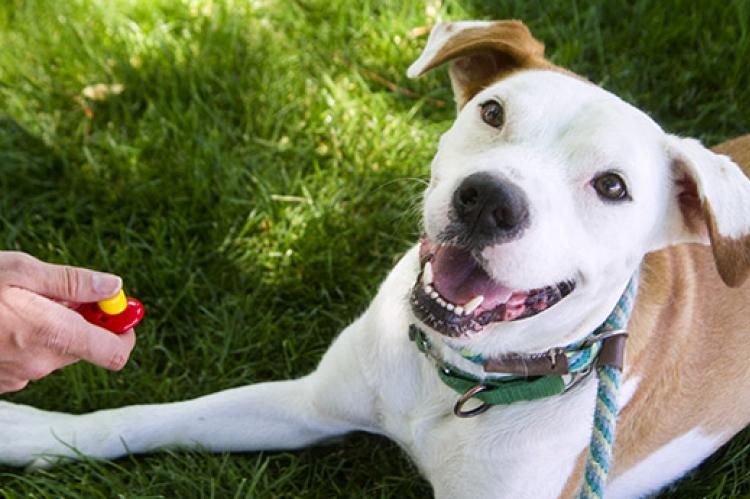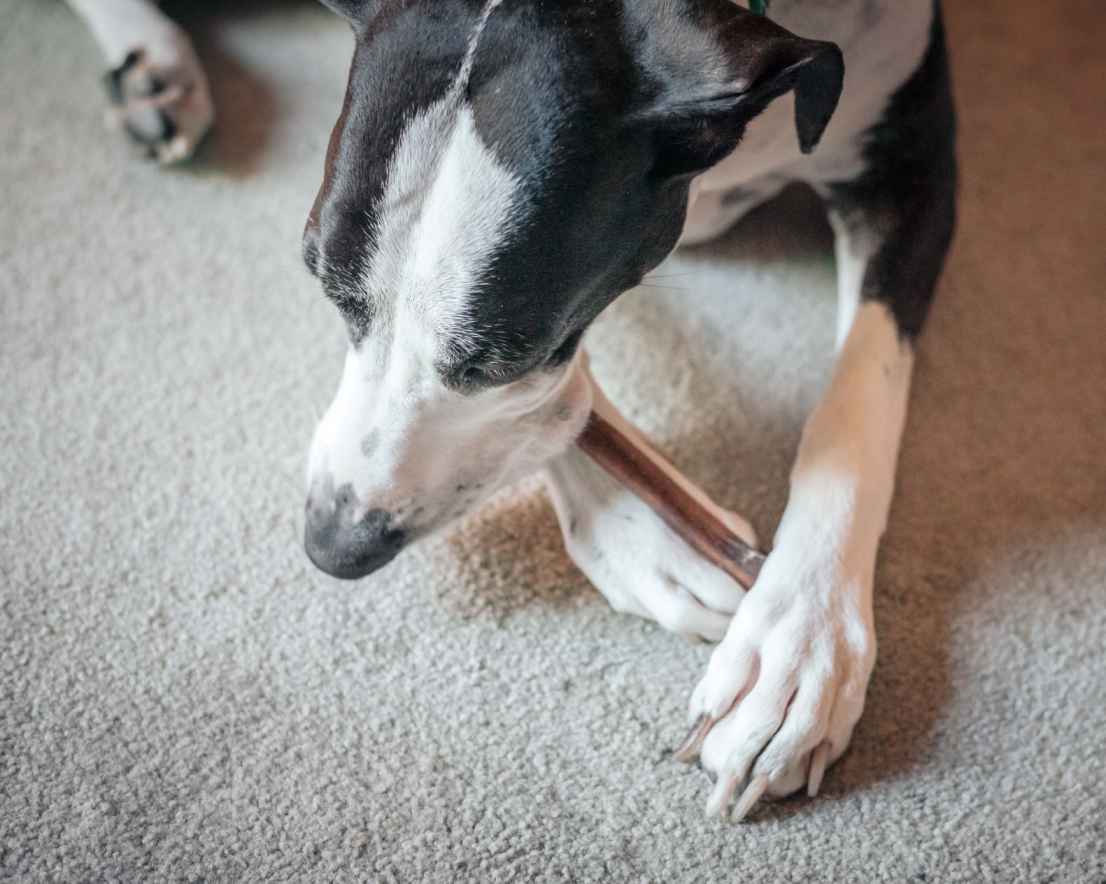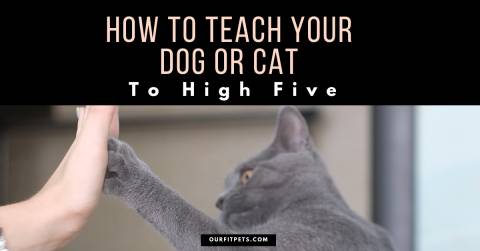Training your dog to lie down is a necessary part of your pup’s training. This cue is one of the basics your dog will need to learn, and it also goes along with the sit cue.
Connect with a verified veterinarian in minutes. Licensed vets are available 24/7 to answer your questions. No need to worry about your furry family member.
The Benefits of Training Your Dog to Lie Down
The lie down cue is useful for when you’re at home, outside, at the vet’s, etc. You can also use this cue when around other animals and when your fur baby needs to calm down in stressful situations. It’s also a good way to teach your dog to stay when told.
One note about the lie down cue—this is a position of submission for your dog. When in a pack situation, a submissive dog will lie down on his back, tummy up, before a more dominant dog. While the lie down cue is not this most submissive position, your canine friend may still feel as if he’s being commanded to be submissive, which may be challenging for more dominant dogs.
What is the Lie Down Position?
The lie down position is when a dog has his stomach, chest, legs, elbows and hocks in touch with the floor or the ground. It’s important to note that your furry companion should remain in this position until you give him the “release” cue.
The release cue means that you’re giving him permission to get up out of the lie down position, but he should only do this on your cue.
Things to Keep in Mind
Teaching or training should be done in a place your dog feels comfortable. Your pup may feel more comfortable out in the backyard or in the park. He may even feel more comfortable training inside your home. Experiment to find where your dog feels the most comfortable for your training sessions. You might be thinking “I should find dog training classes near me” instead of doing it myself, if you have the budget by all means yes! Using a professional will certainly yield faster and better results.
Most dogs will feel more comfortable on a surface where their feet can’t slide. You might consider a grassy spot outside, carpeting or your dog’s favorite rug or bed. Also look for a place with few distractions if your fur baby is easily distracted by other dogs, people, etc.
Items You’ll Need
You don’t need any fancy equipment to train your dog to lie down. Just have a few of his favorite treats on hand, that comfortable place we discussed, along with a good dose of patience!
Training Your Dog to Lie Down
Different trainers have developed complex strategies to teach your dog to lie down. While it can be challenging to choose a specific method, the process doesn’t have to be too complicated. Here’s what you can do:
1). Start with your dog in a standing or seated position.
2). Make sure to get your pup’s attention first and then show him there’s a treat in your hand.
3). Next, put the treat up to your dog’s nose, then move the treat slowly down to the floor/ground. Chances are your dog will move his head with the treat in sight, following it to the ground with his nose. He doesn’t want to miss something yummy! Keep the treat on the ground until your dog gets into a lying position (as noted above). When he’s in the proper position, then give him the treat as his reward. Be sure to give him lots of praise, too!
4). Keep repeating steps 1-3 until your fur baby consistently follows the treat and lies down. Following strict steps to train your dog will be key to be successful.
5). Once your dog is consistently following the treat and lying down, then add in the verbal cue of “lie down” or “down.” When moving the treat to the ground, firmly (with assertion, but in a kind manner) speak the “down” cue, holding the treat on the ground until your dog is in the proper position. Do this several times to make sure your dog understands the cue and is responding as he should before moving onto the next step.
6). Now try giving the verbal command without the lowering the treat to the ground—if your pup gets into the proper position, then give him the treat and a healthy dose of praise! Keep doing this until your dog is consistently getting into the lie down position. The next step is training him to lie down without the treat reward, but do include plenty of praise.
Stay Command
Once your fur baby has mastered the lie down cue, he’ll need to learn how to stay. This is part learning to lie down (or sit)—your dog needs to remain in position until you give him permission to get up.
a). For now, start with your dog in a lying down position. (You can also start your pup from a seated position, but right now, we’re trying to get him to associate lying down and staying).
b). Use a hand signal—such as the universal signal for stop, which is a hand raised, palm outwards toward your pup, with fingers together and pointed up.
c). When you say “stay” and give the hand signal, only reward your dog if he stays in position for a few seconds. Only reward him if he stays—not if he gets up! Also give him lots of praise when he gets it right. While your dog is staying on the grass, make sure he is paying attention! You do not want your dog eating worms or other things he could find amusing.
Begin practicing the stay command for several short sessions. With each session, try to get your dog to stay for slightly longer periods. In addition, increase the distance between you and your dog so he gets used to staying, even if you’re not directly near him.
It’s also a good idea to practice the stay command in different situations and in different places, so your dog learns to stay under all circumstances.
And finally, don’t forget to give your dog the release cue, which gives him permission to get up!

Review symptoms, medications & behavior to keep your pets healthy with a Vet Online in just minutes.
Ask a Vet Live NowFive Tips for Teaching Your Dog to Lie Down
Here are a few tips for teaching your dog to lie down, as well as things to keep in mind during the training process:
1). Your dog may be one who would rather stand before lying down—that’s OK. Or he may be one that prefers lying down from a seated position. Starting from either a sitting or standing position is OK.
2). If your fur baby’s easily distracted, be sure to have training sessions in a quiet, calm place—a place your dog feels comfortable. Another option is to start each training session by giving your dog about 4-5 small treats. Food will usually gain his attention pretty quickly!
3). When praising your dog for lying down, be sure to do so in a calm manner. If you are too exuberant, then this will be a signal to your fur baby to get up and get excited, too! You want your dog to remain in the down position until you cue him to get up. So, practice giving him calm praise to keep him calm and attentive, rather than overly excited.
4). Be sure your canine companion gets enough exercise in his day, especially before training sessions. This way, he’ll have released excess energy and will be more relaxed and able to concentrate on learning.
5). Remember to have patience with your pet at all times. All dogs are different, with each one learning at their own pace. Don’t become frustrated if your pup doesn’t quickly learn to lie down on cue. Instead, be patient with him and consider other training methods that may work better with your dog. Some dogs learn with treats, while others may respond better to the use of one of the best dog clicker and treats, etc.
We hope you will find these training steps and tips useful when teaching your fur baby to lie down. If you have any questions about what method might be best for your dog, seek out your dog’s veterinarian or breeder for advice. You might also consider using an experienced dog trainer for assistance with your pup. We wish you and your fur baby all success in your training endeavor!
Connect with a verified veterinarian in minutes. Licensed vets are available 24/7 to answer your questions. No need to worry about your furry family member.

Tom
Tom has always loved to write since he was little - he wanted to be either a writer or a veterinary doctor, but he ended up being a professional writer while most of his works are based on animals. He was born in San Francisco but later moved to Texas to continue his job as a writer. He graduated from the University of San Francisco where he studied biotechnology. He is happily married and a soon to be father!
Review symptoms, medications & behavior to keep your pets healthy with a Vet Online in just minutes.
Ask a Vet Live Now



